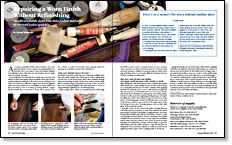Repairing a Worn Finish Without Refinishing
Alcohol-soluble dyes bite into faded surfaces to restore color quickly
Synopsis: Restorer Pinchas Wasserman often sees furniture that doesn’t need drastic refurbishing, just touching up. He prefers alcohol-soluble dyes among the options available for this job, because their capacity to bite into a finish or sealed wood makes them uniquely suited for repairing finishes. He explains the two basic types available and how to mix and apply them. Photographs illustrate the methods he uses. A side explanation by finisher Jeff Jewitt explains how aniline dye got its name and what it means today.
As a restorer, primarily of 20th-century furniture, one of my typical problems is how to improve an existing finish for a customer who is not ready to have the furniture stripped and refinished. More often than not, the furniture doesn’t really need such drastic measures.
In cases like that, I’ve found alcohol-soluble dyes to be the most effective solution among the options available. These dyes receive mostly peripheral treatment in discussions about coloring wood. They are vastly more difficult to apply than oil-based pigment stains, and many of them are not as lightfast as water-soluble anilines. Yet when it comes to touching up existing finishes, I regard alcohol-soluble dyes as the premier colorant. Their capacity to bite Padding lacquer applied by cloth— Applied with a quick, buffing motion, padding lacquer blends finish repairs and seals in alcohol-soluble dyes. No stripping required. Working with alcohol-soluble dyes and a fine brush, the author makes repairs to this walnut desk that will be virtually undetectable. Squirrel-hair brushes for blending large areas of color—Keep brushes soft and supple with occasional dips in denatured alcohol. A into a finish or sealed wood makes them uniquely suited for restoring worn finishes (see the bottom left photo).
Only your chemist knows for sure
Two kinds of alcohol-soluble dyes are commonly available: basic dyes and metal-complex dyes. Both may be sold as aniline dyes (see the box on the facing page). Basic dyes, available through many woodworking catalogs, are the most common and are available in a greater range of premixed wood-tone colors. Not all of these are considered lightfast. But with small areas of worn or chipped finishes, lightfastness is not that important.
Metal-complex dyes, which are manufactured by Ciba-Geigy and BASF (see the sources of supply below), are less common, more expensive (not that you’ll need much for touch-up work) and more resistant to fading. For practical purposes when touching up finishes, there is not a great difference between the two. Both are excellent, powerful dyes.
From Fine Woodworking #128
For the full article, download the PDF below:
Fine Woodworking Recommended Products

Bumblechutes Bee’Nooba Wax


Foam Brushes






















Log in or create an account to post a comment.
Sign up Log in